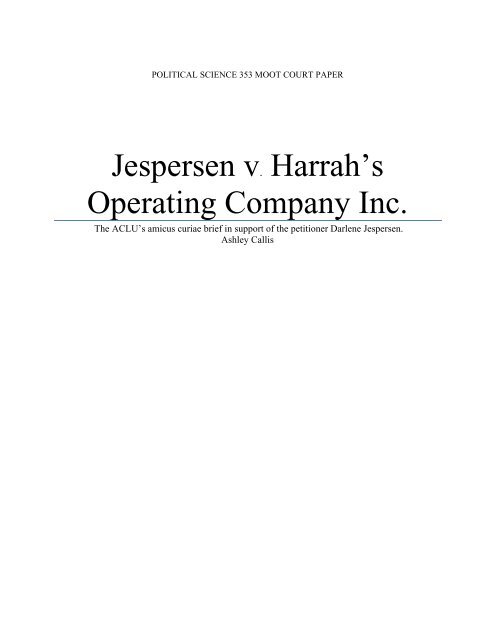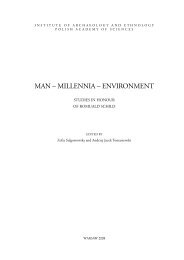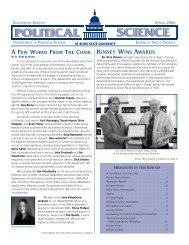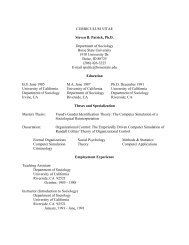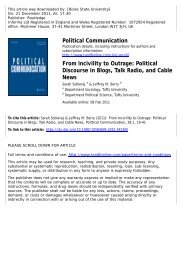Jespersen v. Harrah's Operating Company Inc. - College of Social ...
Jespersen v. Harrah's Operating Company Inc. - College of Social ...
Jespersen v. Harrah's Operating Company Inc. - College of Social ...
You also want an ePaper? Increase the reach of your titles
YUMPU automatically turns print PDFs into web optimized ePapers that Google loves.
POLITICAL SCIENCE 353 MOOT COURT PAPER<br />
<strong>Jespersen</strong> v. Harrah’s<br />
<strong>Operating</strong> <strong>Company</strong> <strong>Inc</strong>.<br />
The ACLU’s amicus curiae brief in support <strong>of</strong> the petitioner Darlene <strong>Jespersen</strong>.<br />
Ashley Callis
IN THE<br />
Supreme Court <strong>of</strong> the United States<br />
DARLENE JESPERSEN,<br />
-v-<br />
Petitioner,<br />
HARRAH’S OPERATING COMPANY INC.,<br />
Respondent.<br />
ACLU AMICUS CURAE BRIEF IN FAVOR OF DARLENE JESPERSEN,<br />
PETITIONER<br />
Page | 2
TABLE OF AUTHORITIES<br />
Cases<br />
Page | 3<br />
1. Carroll v. Talman Federal Savings and Loan Association <strong>of</strong> Chicago, 604 F.2d 1028<br />
(1979)<br />
2. Frank v. United Airlines <strong>Inc</strong>., 216 F.3d 845 (2000)<br />
3. <strong>Jespersen</strong> v. Harrah’s <strong>Operating</strong> <strong>Company</strong> <strong>Inc</strong>., 280 F. Supp. 2d 1189 (2002)<br />
4. <strong>Jespersen</strong> v. Harrah’s <strong>Operating</strong> <strong>Company</strong> <strong>Inc</strong>., 444 F.3d 1104 (2006)<br />
5. Nichols v. Azteca Restaurant Enterprises <strong>Inc</strong>., 256 F.3d 864 (2001)<br />
6. Price Waterhouse v. Hopkins, 490 U.S. 228 (1989)<br />
11. ACLU. ACLU.com<br />
Other Authorities<br />
12. Fisk, Catherine L.“ Privacy, Power, and Humiliation At Work: Re-Examining<br />
Appearance Regulation As An Invasion <strong>of</strong> Privacy.” (2006) Duke Law School Faculty<br />
Scholarship Series.<br />
13. Kirshenbaum, Andrea Meryl. “Because <strong>of</strong>…Sex: Rethinking the Protections Afforded<br />
Under Title VII in the Post-Oncale World.” (2006) Albany Law Review, Vol. 69<br />
No.139.<br />
14. Levi, Jennifer L., “ Clothes Don’t Make the Man (or Woman), but Gender Identity<br />
Might.” (2006) Faculty Scholarship Faculty Publications. Western New England<br />
<strong>College</strong> School <strong>of</strong> Law.<br />
15. Lindgren, Ralph J. et al. “The Law <strong>of</strong> Sex Discrimination.” Fourth Edition. Pp 77-109
16. Pizer, Jennifer C. “Facial Discrimination: Darlene <strong>Jespersen</strong>’s Fight Against the<br />
Page | 4<br />
Barbie-fication <strong>of</strong> Bartenders.” (2007) Duke Journal <strong>of</strong> Gender Law & Policy, Vol. 14,<br />
No. 285.<br />
17. “Title VII. Gender Discrimination. Ninth Circuit Holds That Women Can Be Fired for<br />
Refusing to Wear Makeup.” (2006) Harvard Law Review, Vol. 120 No. 2.
INTEREST OF AMICI<br />
Page | 5<br />
The American Civil Liberties Union works “to defend and preserve the individual rights<br />
and liberties that the Constitution and laws <strong>of</strong> the United States guarantee everyone in this<br />
country” (11). It is the duty <strong>of</strong> the ACLU to interviene on behalf <strong>of</strong> those whose Consitutional<br />
rights, and civil liberties are encroached upon, especially when the greivenced party is <strong>of</strong> a<br />
traditionally discrimiated gourp such as, “people <strong>of</strong> color; women; lesbians, gay men, bisexuals<br />
and transgender people; prisoners; and people with disabilities” (11). The question in the case <strong>of</strong><br />
<strong>Jespersen</strong> v. Harrah’s <strong>Operating</strong> Co. <strong>Inc</strong>. is whether an employment issued, gender specific<br />
“uniform” policy is covered as discrimination and a violation <strong>of</strong> Title VII <strong>of</strong> the Civil Liberties<br />
Act. The employment policy at hand requires all female bartenders to wear makeup to work, this<br />
is a perpetuation <strong>of</strong> a sexual-stereotype that women must wear makeup in order to be viewed as<br />
pr<strong>of</strong>essional and attractive. The matter at hand may appear to be a trivial concern about facial<br />
makeup, “but the question arises within a historical continuum <strong>of</strong> dress and decorum demands<br />
that have constrained generations <strong>of</strong> women” (12).<br />
STATEMENT OF THE CASE<br />
In February 2000 Harrah’s <strong>Operating</strong> <strong>Company</strong> began the implementation <strong>of</strong> an<br />
appearance and grooming policy called the “Personal Best” for all beverage department<br />
employees at Harrah’s casino locations. Half <strong>of</strong> the policy requirements were gender neutral, for<br />
instance, “a standard uniform <strong>of</strong> black pants, white shirt, black vest, and black bow tie” (3). The
Page | 6<br />
rest were gender specific requirements: for men, “Hair must not extend below top <strong>of</strong> shirt collar.<br />
Ponytails are prohibited. Hands and fingernails must be clean and nails neatly trimmed at all<br />
times. No colored polish is permitted. Eye and facial makeup is not permitted,” and for females,<br />
“Hair must be teased, curled, or styled. Hair must be worn down at all times. Make up (face<br />
powder, blush and mascara) must be worn and applied neatly in complimentary colors. Lip color<br />
must be worn at all times” (4). For the makeup requirement, Harrah’s hired a cosmetic artist who<br />
gave consultations to the female employees and a diagram <strong>of</strong> how to put on their makeup in each<br />
day for work. By May 5 2000, after Plaintiff, who never wears makeup in her day-to-day life,<br />
made an attempt to conform to the new policy, stated that the makeup made her feel “extremely<br />
uncomfortable, ill and violated,” and would discontinue wearing the required cosmetics. In<br />
response the Defendant <strong>of</strong>fered Plaintiff the opportunity to view Harrah’s job <strong>of</strong>ferings that did<br />
not have a makeup requirement; <strong>Jespersen</strong> refused and was terminated as a result (3). The<br />
Plaintiff filed suit against Defendant with the United States District Court for the District <strong>of</strong><br />
Nevada claiming that Harrah’s <strong>Operating</strong> Co. <strong>Inc</strong>. discriminated against her in violation <strong>of</strong> Title<br />
VII; the District Court <strong>of</strong> Nevada granted a summary judgment for the Defendant. A summary<br />
judgment is a decision in favor <strong>of</strong> one party in order to spare courts from “unnecessary trials”<br />
when the presiding judges determine that the opposing party does not have enough evidence to<br />
make a case (3). In <strong>Jespersen</strong> v. Harrah’s <strong>Operating</strong> Co. <strong>Inc</strong>., the District Court, decided that the<br />
Plaintiff did not have enough evidence to prove discrimination as defined by Title VII. The<br />
Plaintiff appealed the District Court’s summary judgment to the United States Court <strong>of</strong> Appeals<br />
for the Ninth Circuit. The Circuit Court stated that the Plaintiff failed to establish a prima facie
Page | 7<br />
case in accordance with the Supreme Court’s order <strong>of</strong> pro<strong>of</strong> under Title VII, and thus affirmed<br />
the District Court’s summary judgment in favor <strong>of</strong> Harrah’s. As a means <strong>of</strong> last resort, <strong>Jespersen</strong><br />
filed a writ <strong>of</strong> certiorari with The United States Supreme Court.<br />
A. TITILE VII<br />
ARGUMENT<br />
Congress created Title VII <strong>of</strong> the Civil Liberties Act as a means <strong>of</strong> protection against<br />
discrimination towards members <strong>of</strong> traditionally ostracized groups in employment, the most<br />
widely used provisions <strong>of</strong> Title VII are:<br />
(1) It shall be an unlawful employment practice for an employer to fail or<br />
refuse to hire or to discharge any individual, or otherwise to discriminate<br />
against any individual with respect to his compensation, terms conditions,<br />
or privileges <strong>of</strong> employment, because <strong>of</strong> such individual’s race, color,<br />
religion, sex, or national origin or<br />
(2) To limit, segregate, or classify his employees or applicants for<br />
employment in any way which would deprive or tend to deprive any<br />
individual <strong>of</strong> employment opportunities or otherwise adversely affect his<br />
status as an employee, because <strong>of</strong> such individual’s race, color, religion,<br />
sex, or national origin. (15)
Page | 8<br />
Furthermore, in 1991 Congress decided to amend the Civil Liberties Act to increase the covered<br />
provisions, the amendment stated that, “an unlawful employment practice is established when the<br />
complementary party demonstrates that sex was a motivating factor for any employment<br />
practice, even though other factors may motivate” (13). In the present case, Plaintiff <strong>Jespersen</strong><br />
argues disparate treatment from Defendant Harrah’s <strong>Operating</strong> Co. <strong>Inc</strong>., stating that the<br />
“Personal Best” policy on appearance and grooming was more burdensome towards women,<br />
amounted to gender stereotyping, and constituted an employment practice that adversely affected<br />
certain employees because <strong>of</strong> sex in accordance to Title VII provisions (3)(4). As defined by the<br />
Supreme Court there are two forms <strong>of</strong> Title VII discrimination, disparate treatment, which is an<br />
obvious and intentional discrimination by the employer, and disparate impact, which is an act or<br />
policy created by the employer that does not seem discriminatory, but has a discriminating effect<br />
(15). <strong>Jespersen</strong> brought suit against Harrah’s as a victim <strong>of</strong> disparate treatment, and thus<br />
disparate impact shall be omitted from the argument; though, whether an employer’s actions<br />
amount to obvious discrimination or has a discriminatory effect does not matter given that, “in<br />
the implementation <strong>of</strong> employment decisions, it is abundantly clear that Title VII tolerates no<br />
discrimination, subtle or otherwise” (6).<br />
1. Greater Burden:<br />
The Plaintiff argues that the “Personal Best” policy, implemented by the Defendant,<br />
created a greater burden for women employees than for male employees. The policy in question<br />
required that men maintain a short haircut and clean, trimmed nails, while requiring women to<br />
have their “hair teased, curled, or styled every day, and makeup (face powder, mascara, and<br />
blush)” (3)(4). Though both the hair and make up requirements constitute a situation <strong>of</strong> greater
Page | 9<br />
burden, <strong>Jespersen</strong> claims only to have issue with the make up requirement, that it “costs more<br />
money and takes more time for a woman to comply with the makeup requirement” (4) and that<br />
these “added burdens <strong>of</strong> cost and time had no equivalent counterparts for male employees” (17).<br />
Unequal burdens can take multiple forms, “unequal economic, physical and psychological<br />
burdens, and Harrah’s imposed all three burdens unequally among women” (17). As already<br />
mentioned, the economic cost for female employees at Harrah’s was much greater than for the<br />
male employees, whose only costs “were the price <strong>of</strong> a monthly haircut and a trivial one-time<br />
investment in fingernail clippers” (17). In a similar case, Carroll v. Talman, female employees<br />
were required to wear uniforms while the men were not; in this case the Appeals Court for the<br />
Seventh Circuit decided in favor <strong>of</strong> the female employees because only the women had a specific<br />
uniform while the men only had a dress code, furthermore, the female employees were “required<br />
to pay for the cleaning and maintenance <strong>of</strong> their uniforms. If a part <strong>of</strong> the uniform becomes lost<br />
or damaged the employee must replace it at her own expense” (1). As in Carroll v. Talman,<br />
Harrah’s female bartenders were the only one’s required to wear a “facial uniform,” while at the<br />
same time, the “Personal Best” policy did not even require male employees to shave, “nor did his<br />
hair need to be washed or neatly combed;” (17). Furthermore, female employees, similar to<br />
Carroll, were responsible for buying makeup, replacing it when it had been used or if lost; and as<br />
the uniforms in Carroll portrayed that women could not look pr<strong>of</strong>essional on their own,<br />
“Harrah’s policy unavoidably conveys a message that women-and not men-are incapable <strong>of</strong><br />
making appropriate decisions about how to prepare their faces in the morning” (16). The<br />
physical burden imposed on women “stood in stark contrast to the standards for men, who had<br />
no time-consuming daily requirements,” (12) and as stated by Judge Kozinski in his dissenting
Page | 10<br />
opinion for <strong>Jespersen</strong> v. Harrah’s, “Even those <strong>of</strong> us who don’t wear makeup know how long it<br />
can take from the hundreds <strong>of</strong> hours we’ve spent over the years frantically tapping our toes and<br />
pointing to our wrists” (4). As for the psychological burden imposed by Harrah’s “Personal<br />
Best” policy, the decision to wear makeup, “literally the face one presents to the world- is an<br />
intensely personal choice” (4); <strong>Jespersen</strong> felt that being forced into altering her appearance with<br />
cosmetics “would conflict with her self-image” (17) and that “submitting to the artificial ‘dolling<br />
up’ made her feel so exposed, demeaned, and alienated that she could not do her job effectively”<br />
(16). The EEOC guidelines regarding unlawful sex discrimination in accordance with Title VII<br />
defined sexual harassment to include, “such conduct that has the purpose or effect <strong>of</strong><br />
unreasonably interfering with an individual’s work performance or creating an intimidating,<br />
hostile or <strong>of</strong>fensive working environment” (13). Yet the Circuit Court decided that <strong>Jespersen</strong><br />
lacked the evidence to support her claim <strong>of</strong> greater burden, they felt that both men and women<br />
were subjected to “grooming” requirements, and stated that, “grooming standards that<br />
appropriately differentiate between the genders are not facially discriminatory” (4).<br />
2. “Because <strong>of</strong> Sex” Gender Stereotyping:<br />
In the case <strong>of</strong> Nichols v. Azteca Restaurant Enterprises <strong>Inc</strong>. the Ninth Circuit stated that,<br />
“sexual harassment is actionable under Title VII to the extent that it occurs ‘because <strong>of</strong>’ the<br />
Plaintiffs sex” (5). Also in the case <strong>of</strong> Price Waterhouse v. Hopkins the Supreme Court held that,<br />
“we are beyond the day when an employer could evaluate employees by assuming or insisting<br />
that they matched the stereotype associated with their group, for in forbidding employers to<br />
discriminate against individuals because <strong>of</strong> their sex, Congress intended to strike at the entire<br />
spectrum <strong>of</strong> disparate treatment <strong>of</strong> men and women resulting from sex stereotypes’” (6). In the
Page | 11<br />
case at hand the Plaintiff argues that requiring female employees to wear makeup is based on a<br />
stereotypical view <strong>of</strong> what a woman should look like, and that this policy is in direct opposition<br />
to Title VII restrictions against discriminative employment policies that are created because <strong>of</strong><br />
sex. Judge Kozinski’s dissenting opinion for <strong>Jespersen</strong> v. Harrah’s <strong>Operating</strong> Co. <strong>Inc</strong>. states that<br />
the Plaintiffs’, “termination for failing to comply with a grooming policy that imposed a facial<br />
uniform on only female bartenders is discrimination ‘because <strong>of</strong>’ sex. Such discrimination is<br />
clearly and unambiguously impermissible under Title VII, which requires that ‘gender must be<br />
irrelevant to employment decisions’” (4). Often times an employer will defend a discriminatory<br />
policy by explaining that gender was not the only factor or motive in creating the policy, this is<br />
known as mixed motive situation. Turning back to the case <strong>of</strong> Price Waterhouse v. Hopkins the<br />
majority opinion stated that if gender is even a partial factor to any policies or decisions made by<br />
an employer it is covered by Title VII restrictions, unless the employer can prove that the same<br />
actions would have been taken no matter the gender. In regard to the Defendant’s “Personal<br />
Best” policy, it can hardly be said that the policy forcing female employees to wear makeup<br />
would have been created no matter the gender, given that the aspect <strong>of</strong> the policy at issue applies<br />
only to women. The stated purpose for the policy is a means <strong>of</strong> ensuring good grooming habits<br />
among the employees, however requiring females to curl, tease, or style their hair, and wear<br />
powder, mascara, blush, and lipstick to work each day is by no means a matter <strong>of</strong> grooming and<br />
achieving a look <strong>of</strong> pr<strong>of</strong>essionalism. Justice Kozinski states that, “The inescapable message is<br />
that women’s undoctored faces compare unfavorable to men’s, not because <strong>of</strong> a physical<br />
difference between men’s and women’s faces, but because <strong>of</strong> a cultural assumption- and gender
Page | 12<br />
based stereotype- that women’s faces are incomplete, unattractive, or unpr<strong>of</strong>essional without full<br />
makeup” (4).<br />
B. BONA FIDE OCCUPATION QUALIFICAITON<br />
The only recourse for an employer being accused <strong>of</strong> discriminatory actions is to (as stated<br />
above) prove that the action would have been carried out no matter the gender, or by displaying<br />
that the discrimination qualifies as a bona fide occupation qualification (BFOQ). When proving a<br />
BFOQ the Defendant must show that the “challenged policy or practice is a business necessity,<br />
rather than merely a ‘business convenience’” (15). As stated in the case <strong>of</strong> Frank v. United<br />
Airlines <strong>Inc</strong>. and in relation to Harrah’s “Personal Best” policy, “a sex-differentiated appearance<br />
standard that imposes unequal burdens on men and women is disparate treatment that must be<br />
justified as a BFOQ” (2). Shortly after creation <strong>of</strong> the BFOQ, the Equal Employment<br />
Opportunity Commission (EEOC) became concerned that it would be interpreted too broadly,<br />
and effectually weaken the provisions <strong>of</strong> Title VII.<br />
1. EEOC:<br />
To limit the used <strong>of</strong> BFOQ the EEOC urged courts to interpret BFOQ narrowly, and gave<br />
a list <strong>of</strong> instances that do not warrant the application <strong>of</strong> bona fide occupational qualifications:<br />
(1) Refusal to hire a woman based on assumptions <strong>of</strong> the characteristics in general, (2) Refusal<br />
to hire based on stereotyped characteristics <strong>of</strong> either sex, the principle <strong>of</strong> nondiscrimination<br />
requires that individuals be considered on the basis <strong>of</strong> individual capacities, (3) Refusal to
Page | 13<br />
hire an individual because <strong>of</strong> the preference <strong>of</strong> coworkers, the employer, clients or customers<br />
(15).<br />
2. CUSTOMER PREFERENCES AREN’T PROTECTED UNDER BFOQ:<br />
In the Defendant’s testimony giving a non-discriminatory purpose for the “Personal Best”<br />
policy they stated, “that makeup completes the uniformed look for female employees, and that<br />
women’s faces benefit from makeup due to the purported rigors <strong>of</strong> casino lighting” (16). This<br />
does not qualify as a bona fide occupation qualification, whether a female bartender looks<br />
attractive or not has no affect on their job performance. However, it does fall under the category<br />
<strong>of</strong> customer preference, given that most male bar-goers would rather an “attractive” female wait<br />
on them. As stated in Carroll v. Talman, “possible customer preference is not a defense to an<br />
employment policy which makes a distinction upon grounds not permitted by Title VII” (1).<br />
CONCLUSION<br />
The American Civil Liberties Union recommends to the Supreme Court that based on the<br />
above-mentioned precedents, court opinions, and law, the decision in the case <strong>of</strong> <strong>Jespersen</strong> v.<br />
Harrah’s <strong>Operating</strong> Co. <strong>Inc</strong>. should be in favor <strong>of</strong> the Plaintiff. As the inequalities between men<br />
and women continue to permeate the American culture (12), it is seemingly small-scale decisions<br />
such as these that eventually make for changes in people’s prejudice and create an environment<br />
for more opportunities for traditionally discriminated groups.
Page | 14
Page | 15


